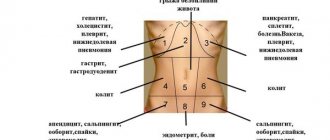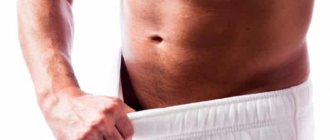Pain is often a sign of pathologies of internal organs, which especially concerns discomfort in the abdomen or side. However, sometimes unpleasant sensations can be a consequence of physiological processes. Why does the left or right lower abdomen hurt before menstruation, and what to do if such pain occurs too often?
Physiological pain, or when you shouldn’t worry if your stomach hurts
Premenstrual pain is familiar to many. Complaints of discomfort in the lower abdomen during menstruation are quite common in gynecology. Factors that can cause abdominal discomfort also include stressful situations, physical and sexual abuse, excessive alcohol consumption and drug use. A crowded large intestine and a spasm of an empty stomach often cause abdominal cramps in women.
In addition, in the first months of pregnancy, the expectant mother may experience pain caused by stretched abdominal muscles and ligaments. Read more about the causes of abdominal pain during pregnancy →
What treatment
After making a diagnosis, the specialist selects the necessary method of therapy. To treat pain during menstruation, medications are used depending on the disease:
- For endometriosis, medications containing hormones are prescribed.
- If salpingitis is detected, antibiotics are prescribed.
- Non-steroidal anti-inflammatory drugs (NSAIDs) will help with cystitis. For example, Voltaren or Indomethacin. To speed up recovery, the patient is prescribed antibiotics.
For treatment, the doctor may prescribe a course of antibiotics
- In case of ulcerative colitis, it is necessary to adjust your diet and take medications for inflammation, as well as immunomodulators. If treatment is ineffective, surgery helps.
- You can get rid of an ectopic pregnancy or ovarian torsion through surgery.
Pain in the left abdomen is a serious sign. Violation can signal various diseases in the body. Therefore, if discomfort occurs, it is better to consult a gynecologist. The specialist will conduct an examination, study the results of all tests, make a diagnosis and prescribe the appropriate treatment.
What pains are considered pathological?
In addition to physiological pain, a woman may also be bothered by pathological pain, which can be caused by ailments of the female genital organs or disruption of the functioning of body systems. Inflammatory diseases of the fallopian tubes, uterus, ovaries, and vagina can cause pain and colic in the lower abdomen. For example, a large ovarian cyst or endometriosis, colpitis and adhesions, fibroids can not only cause pain in the lower abdomen, but also provoke a sharp rise in body temperature and discharge from the genital tract.
Inflammatory diseases of the urinary tract (pyelonephritis, cystitis and others) are also accompanied by colic in the lower abdomen. In addition, women in this case experience an increase in temperature, swelling, and pain when urinating.
Disorders in the pelvic organs, such as hernias, diverculosis and others, are often accompanied by pain. Inconstant stool and frequent constipation can cause intestinal hypertrophy and lead to thickening of the intestine; in addition to pain in the lower abdomen, this disease provokes a decrease in appetite and causes flatulence.
Oncological diseases, for example, cancer of the cervix, uterine body, and ovaries, can also cause abdominal pain in women.
There are many diseases that are accompanied by abdominal pain and require urgent surgical intervention. Appendicitis, ectopic pregnancy, rupture of a cyst, torsion of uterine fibroids, perforation of an ulcer and other dangerous diseases can end in failure if the woman is not promptly provided with qualified medical care.
Infectious diseases and intoxication of the body may be accompanied by stool upset, vomiting, and abdominal pain.
This symptom may indicate many gynecological disorders:
- ovarian rupture (may be accompanied by bleeding or occur without hemorrhage, but in any case, severe abdominal pain is typical for such a situation);
- varicose veins - dilation of the veins in the pelvis can be accompanied by unpleasant sensations and even quite severe pain;
- proliferation of uterine fibroids;
- tuberculosis of the genital organs;
- congenital pathologies of the genital organs;
- algodismenorrhea - painful periods;
- inflammatory processes of the genital organs in the acute stage;
- ovarian hyperstimulation, usually while taking hormonal drugs;
- adhesions;
- incorrectly installed uterine device;
- threat of miscarriage at various stages.
Pain in the lower abdomen on the right
As a rule, with abdominal pain, it can be quite difficult to independently determine the exact location of its localization. Diffuse colic in the lower abdomen significantly complicates the diagnosis.
The first thing that comes to mind when it comes to abdominal pain on the right side is inflammation of the appendix. But there are many other diseases that are characterized by similar manifestations.
If a woman experiences discomfort on the right side, this may indicate pathological damage to the walls of the digestive tract. As a rule, at the beginning of the disease the pain is localized in the iliac region, but later the symptoms can descend to the lower abdomen.
Discomfort on the right side can also occur with:
- right-sided lesions of the ovary, appendages, uterus;
- right-sided lesion of the fallopian tube;
- inflammation of the ureter,
- cystitis,
- urolithiasis,
- cholecystitis,
- pyelonephritis,
- liver inflammation,
- intestinal inflammation,
- ulcerative right-sided colitis.
Sharp pain in the lower abdomen indicates an acute process; in this case, first of all, it is necessary to exclude pathologies that require immediate surgical intervention (termination of a tubal pregnancy, appendicitis, etc.).
Cramping pain on the right side is characteristic of renal colic and tubal pregnancy. With renal colic, pain can radiate to the lower back, groin, and inner thigh. With gynecological problems, pain radiates to the sacrum and rectum.
Many diseases can manifest themselves in this way, so it is important to note the nature, intensity of pain, and their frequency, so that it is easier for the doctor to establish a diagnosis and make a decision about the upcoming treatment.
Pain in the lower abdomen on the left side
Such worries are symptomatic of several diseases. A woman needs to pay attention to the nature of the pain and its intensity.
The main causes of discomfort:
- inflammatory process in parts of the large intestine. This disease is also accompanied by stool disorder or constipation, bloating and nausea. Usually, if you follow a diet, such pain disappears after a couple of days, but if the pain only intensifies, then you should consult a doctor.
- diseases of the genitourinary system. Localization of pain on the left side is also possible with some gynecological diseases (adnexitis, inflammation of the ovarian cyst, etc.).
- pain in the lower abdomen on the left side may be a symptom of an ectopic pregnancy. The pain seems to roll from right to left and is in the nature of contractions. If this pathology is suspected, a woman needs urgent hospitalization and the help of a surgeon to avoid rupture of the fallopian tube. Read more about the signs of ectopic pregnancy →
In order to accurately determine the cause of colic and pain in the abdomen on the left, it is necessary to undergo a comprehensive examination, since all diseases that are characterized by pain on the right side can also cause pain on the left (of course, except for inflammation of the appendix). In addition, radiating pain on the left can appear with a heart attack, acute pancreatitis and other diseases.
Before the onset of menstruation
Quite often, women experience pain in the lower abdomen before the onset of menstruation. In general, menstruation should not be accompanied by pain; it is allowed only in the first days of the cycle.
The main reason for discomfort in the lower abdomen before the onset of menstruation is hormonal changes in the blood. This is a physiological reason associated with the individual structure of a woman’s body.
But there are also pathological reasons for the appearance of this disease before menstruation. Severe pain or colic in the lower abdomen before menstruation should alert a woman and become a reason to consult a doctor, as it may indicate hormonal imbalance, uterine fibroids, endometriosis, inflammation of the ovaries and fallopian tubes, as well as a number of infectious diseases of the reproductive system.
Abdominal discomfort before menstruation can be a concern for women who have recently had a termination of pregnancy; as a rule, it occurs for several cycles and then goes away.
Stressful situations, depression, and thyroid dysfunction can lead to pain before and after menstruation. The unpleasant sensations that occur before menstruation are usually pulling or aching, sometimes they radiate to the lower back or legs.
In the middle of the cycle
Such pain can bother a woman due to slight bleeding from the ovary. The blood irritates the wall of the abdominal cavity, causing it to become inflamed - this is the cause of pain.
If a woman is bothered by her lower abdomen in the middle of her cycle, it is usually caused by ovulation, which is a normal physiological process. But, in addition, pain can also be caused by pathologies, such as fibroids, inflammation of the appendages, and infections of the genitourinary system.
In order to clarify the exact cause of pain in the lower abdomen in the middle of the cycle, it is necessary to take tests and undergo a gynecological examination.
After intercourse
Intimacy should bring joy and satisfaction, but sometimes women face a very unpleasant problem when the lower abdomen begins to hurt after sex.
Such sensations may indicate hidden pathological problems in a woman’s body, and pain may also arise due to psychological factors.
Gynecological problems that may cause discomfort after sex:
- rupture of an ovarian cyst or the ovary itself;
- reproductive system disorders;
- the presence of a tumor of the pelvic organs;
- congenital anatomical abnormalities;
- cystitis;
- threat of early pregnancy loss.
Discomfort can also occur in the event of rough sexual intercourse, when the walls of the vagina are injured and the mucous membrane of the cervix is damaged. The appearance of pain and blood only after the first sexual intercourse is considered normal. In other cases, if after sex there is pain in the lower abdomen or bleeding begins, you should immediately go to the hospital, where the woman will receive the necessary medical care.
Prevention
Doctors recommend adhering to the following measures to prevent premenstrual pain:
- visit a gynecologist regularly (once every 6 months);
- every year undergo examination by other specialists (surgeon, endocrinologist, etc.);
- avoid injury to the pelvic organs.
In addition, a woman should avoid taking hormonal contraceptives on her own to avoid disruptions in the body, and should only install an IUD in trusted clinics.
Pain in the side before menstruation is a serious symptom that has many causes and requires timely diagnosis. Only a qualified specialist can establish the correct diagnosis and select the appropriate treatment. If all instructions are strictly followed, the woman returns to her usual lifestyle in a short time.
Not all women keep a schedule by which they can track the regularity and duration of their periods. Most of them quite accurately predict the start date of their next menstruation based on changes in their well-being due to physiological reasons. Pain, discomfort in the lower abdomen, and general malaise two or three days before the onset of menstruation become almost commonplace. Is it necessary to pay attention to the intensity and nature of unpleasant symptoms, depending on the woman’s overall health, hormonal balance indicators, cyclical changes in the organs of the reproductive system, and the severity of premenstrual syndrome? Moderate discomfort felt by a woman before her period is considered physiologically normal. But spasmodic acute pain and noticeable discomfort that are present before menstruation and do not subside with the onset of menstruation should alert every woman and become the basis for visiting a gynecologist.
Severe pain before menstruation or the onset of menstruation does not mean anything good.
Severe throbbing, sharp or cramping pain in the lower abdomen, left or right abdomen, when there is severe stabbing, aching or pulling in the abdomen before the onset of menstruation, this is most often a sign of pathology.
Of course, if you have a severe pain in the lower abdomen before your period, you cannot exclude the possibility of a physiological cause (not dangerous to health). Further in the article, we will go into detail about what diseases there may be if the lower abdomen, left or right abdomen hurts very badly, what diseases there may be if there is very severe pain and symptoms of PMS before menstruation.
What to do if you have pain?
If you experience acute, sharp pain in the abdomen, you should immediately lie down and try to relax. Try to adequately determine the location of pain, its nature, intensity and frequency. If the pain is very sharp, then you should not delay, you should immediately call an ambulance.
In general, if you are periodically bothered by pain in your lower abdomen, it is recommended to undergo a full examination. Mandatory in this case is an ultrasound examination of the abdominal cavity and pelvic organs, donation of blood and urine for a general analysis. If gynecological diseases are suspected, it is necessary to donate blood for hormones and smears for infections. In addition, depending on the causes and nature of the pain, the doctor may prescribe additional tests.
There are a great many reasons why the lower abdomen may hurt. Among them are gynecological, proctological, vascular, gastroenterological, proctological, neurological, and psychogenic.
You should not ignore pain, because sometimes it is a symptom of quite dangerous pathologies.
Most women can predict the onset of their expected menstruation in advance. This happens due to the unpleasant manifestations of premenstrual syndrome, the characteristic symptoms of which are difficult to confuse with anything else. Among its symptoms, girls especially often note pain in the pelvic area. Are they always physiological in nature, and in what case should you start worrying about your own health?
What abnormalities in the ovaries can be diagnosed?
Pain on the left during menstruation occurs with diseases associated with the ovaries:
- tear or torsion on the left side;
- cyst.
An ovarian cyst is accompanied by very strong and sharp pain
Rupture or torsion of the left ovary
In this case, the help of a doctor is urgently required. If the pathology is not treated in time, the organ tissues become necrosis (necrosis) due to increased inflammation.
There are rare cases when the disease appears at rest; most often it occurs with constant strong physical activity. The main symptoms include acute and sharp pain. Discomfort may radiate to the groin or thighs. In addition to discomfort, the patient has a high temperature and increased sweating. Pathology is determined by the appearance of nausea, vomiting, and headaches. Blood may come out of the vagina due to necrosis of the walls of blood vessels.
Ovarian cyst
It is a common pathology. The tumor may be in the left or right ovary. Cyst symptoms include:
- acute or nagging pain;
- disturbance in the menstrual cycle;
- changes in the functioning of the gastrointestinal tract;
The cause may also be problems in the digestive system.
- severe pain before menstruation;
- edema;
- temperature rise to high values.
If a woman ruptures a cyst, dangerous complications may arise in the form of peritonitis, infertility and others.
Causes of pain in the side before menstruation
Normally, ovulation (the release of an egg into the cavity of the fallopian tube) occurs 2 weeks before the start of menstruation, with a regular cycle lasting 28 days. About half of the patients feel the approach of the ovulatory period and the onset of ovulation itself. Its external symptoms are considered to be:
- enlargement of the mammary glands;
- increased sexual desire;
- increased appetite;
- the presence of small blood stains on the underwear;
- sudden mood swings;
- fatigue and fatigue;
- muted cramping and nagging pain in the lower abdomen.
Painful attacks during ovulation are caused by the fact that in the process of leaving the follicular membrane the egg tears it. This is accompanied by the release of a small amount of blood and interstitial fluid . The fallopian tube begins to contract intensively so that the reproductive cell moves faster inside it. All this irritates the abdominal wall, so the woman experiences slight pain and discomfort .
Inflammation of the ovary
Inflammation of the ovary is a serious pathology, often accompanied by parallel damage to the fallopian tubes. Pain is one of the leading signs of this disease. Ignoring the inflammatory process is fraught with its transition to a chronic form, as well as the occurrence of complications.
Oophoritis and adnexitis
Oophoritis is an inflammation of the ovaries caused by the penetration of infectious agents (staphylococci, streptococci, E. coli) into the pelvic organs . Bacteria can persist in the patient’s body for a long time and cause an inflammatory process only if its immune and protective forces are reduced (for example, with a sudden loss of body weight, prolonged stressful situations, severe concomitant systemic disease).
Pain during oophoritis tends to intensify before critical days, is painfully cutting in nature and affects the general well-being of the patient: bleeding may become more profuse , the temperature may rise to febrile levels (38-39 ° C). It is also possible to add symptoms of general intoxication (nausea, vomiting, headaches, etc.).
Adnexitis is an inflammatory disease that simultaneously affects the ovaries and fallopian tubes. The pain will be more pronounced, radiating to the sacral region. In addition, with this pathology purulent discharge from the genital tract , difficulty passing urine in small portions, pain and rigidity of the abdominal muscles .
Other reasons
Not only the digestive organs can suffer from the suppression of immunity inherent to menstruation. If there are other health problems, their aggravation is possible. Very often, pathologies of the neighboring urinary system “wake up” or appear for the first time.
| Disease | Causes of pain |
| Cystitis | The bladder becomes inflamed during menstrual periods if the disease is chronic. Exacerbations that favor the growth of bacteria and a general weakening of the body contribute to the aggravation. The localization of pain depends on the location of the most affected areas of the bladder. It can only be found on the right side, in addition to which there is a frequent need to urinate. |
| Pyelonephritis | Inflammation of the kidneys is favored by poor diet, swelling and decreased immunity. A woman may feel a pain in the lower back on the right before her period (if the corresponding kidney is suffering), nausea increases, the temperature rises, and weakness is felt. |
| Urolithiasis disease | Its peak is renal colic, characterized by unbearable pain and vomiting. The sensation does not weaken when changing body position, but may subside slightly after taking antispasmodics. A love of spicy and salty foods and a large amount of liquid drunk can trigger the occurrence of pathology during menstruation. |
| Varicose veins of the pelvis | During menstruation, blood flow to this area increases and swelling occurs. All of these are factors that aggravate the problem. The right side of the pelvis has an increased blood supply due to the characteristics of the circulatory system. Therefore, it is more likely that aching pain will arise here. |
The cause of the sensation must be clarified. After all, most of the reasons for pain in the right side of the abdomen during menstruation are urgent. And delay in treatment can lead to irreparable consequences.
Menstruation is often accompanied by discomfort in the lower abdomen, which appears due to the release of an unfertilized egg along with the uterine mucosa from the body. Pain can occur not only in the genital area, but also in the mammary glands, lower back, some girls notice pain in the right hypochondrium. Why does my right side hurt before my period, and which doctor should I consult?
Moderate pain before menstruation is a physiological norm. During ovulation, the egg is released into the fallopian tubes, awaiting fertilization. If this does not happen, then the reproductive cell must be removed from the body along with the uterine mucosa, which has increased during the period of ovulation. Due to the separation of endometrial cells, blood vessels and nerve endings are damaged, resulting in painful sensations.
With primary dysmenorrhea - a pathology of the menstrual cycle, due to which a woman experiences very severe pain and weakness every month - bleeding may not be very active. In this case, increased discomfort is already a deviation from the norm.
Usually pain during menstruation begins on the 2-3rd day, the peak of pain occurs on the 3-4th day. If during ovulation the egg was fertilized, then menstruation does not occur and pain does not appear.
Causes of severe abdominal pain before menstruation
How to distinguish normality from pathology, because each woman has her own individual pain threshold. How to understand when abdominal pain during PMS is normal, and when severe pain in the lower abdomen on the left or right is symptoms of a pathological problem or disease. Severe pain before the onset of menstruation can be interpreted in different ways, depending on how much the woman feels the deterioration of her general condition. The body of women with a low pain threshold cannot cope with even mild pain and needs to take painkillers, but there are women who continue to live and work as usual, despite the presence of intense pain, patiently enduring them and not taking any measures. This situation confuses doctors when they hear complaints of severe pain before menstruation, so they focus on a complex of all symptoms.
The most common symptoms of the onset of premenstrual syndrome are nagging and aching pain in the lower abdomen, which can radiate to the left or right side; sometimes pain in the lower abdomen before menstruation can radiate to the lower back, lower groin, pubic area or tailbone area. But such pain before the onset of menstruation should not be severe; ideally, a woman should feel mild discomfort or moderate pain. A number of factors can negatively affect a woman’s well-being on the eve of her next menstruation:
- Excessive levels of physical exertion due to demanding work conditions or intense workouts in the gym, especially on weight machines, can cause very severe abdominal pain. Sometimes, after serious training, a woman may feel literally unbearable pain in her stomach if her period is about to begin. Strength training before your period often increases soreness, pain, and other symptoms of PMS (premenstrual syndrome).
- The reasons for increased pain before menstruation may lie in staying for a long time in cold conditions, leading to hypothermia. Due to the fact that the body gets cold, especially the legs, spasms may occur in the vessels of the pelvic organs, which increase the sensation of pain on the eve of menstruation. So, before menstruation, habitual and mild pain in the abdomen can turn into a very mild nagging or aching pain in the abdomen.
- Why do abdominal pains only get worse before menstruation? Premenstrual tension syndrome, or more simply, premenstrual syndrome (PMS). Not everyone experiences an uncomfortable state a couple of days before the start of menstruation; in some women it is felt much earlier, 5-7 days. Characteristic symptoms are dull nagging pain in the lower abdomen combined with autonomic and neurological symptoms (tachycardia, headache, sweating, numbness of the extremities). PMS is classified not as a separate pathology, but as a separate symptom complex with different clinical forms, depending on the severity of manifestations that can disrupt the usual lifestyle and limit a woman’s ability to work.
- What could happen if during these periods your stomach hurts much more than usual before menstruation? Lack of sufficient physical activity. Physical inactivity, caused by the “sedentary” principle of work and inactive rest, contributes to the development of blood supply disorders to the pelvic organs and leads to stagnation. This provokes an increase in pain, abdominal pain becomes more noticeable on the eve of menstruation.
- Excess body weight causes a lot of problems in the body, just some of them are delayed menstruation or early menstruation, too much or very scanty discharge during menstruation, very severe abdominal pain before the onset of menstruation. Little known to many is the fact that adipose tissue itself performs, among other things, an endocrine function, that is, it releases hormones, such as estrogen, into the bloodstream. A significant excess of adipose tissue can significantly affect the balance of hormonal levels, and hormonal imbalances often accompany painful menstruation.
- Diseases of the digestive system can cause very painful premenstrual syndrome. Due to pathologies of the stomach and intestines, cramps and bloating (flatulence) are often observed; irritated intestinal loops put pressure on the area of the uterus and appendages, increasing the pain during menstruation.
- Use of an intrauterine device (IUD). For some women, the IUD is an undesirable form of contraception, since it can become one of the causes of dysmenorrhea. If, after installing various types of intrauterine devices, a woman has pain in the lower abdomen and the pain does not go away, if such pain in the lower abdomen after the installation of PMS is regular and appears periodically, you should definitely seek help from a doctor.
- A number of gynecological pathologies, especially those related to the condition of the uterus. Pain of varying intensity can occur against the background of pathological changes in the muscular uterine tissues or with an abnormal anatomical structure, which negatively affects the contractility of the organ or the free outflow of menstrual fluid. This is the presence in the tissues of the uterus of myomatous nodes that deform the uterine cavity, underdevelopment of its structure, narrowing of the cervical canal, displaced location in the pelvic area, endometriotic proliferation of the uterine epithelium outside the boundaries of the organ. All these deviations provoke different pain sensations before the onset of menstruation and during menstruation.
- Consequences of gynecological surgical interventions, complicated course of the postpartum period. Scarring and other changes in the tissues of the genital organs, especially the uterus and appendages, after surgery can cause premenstrual pain.
- Inflammatory processes in the organs of the genitourinary system. Closer to the beginning of menstruation, chronic pyelonephritis, cystitis and other diseases that intensify premenstrual pain syndrome often worsen.
Why does the left lower abdomen hurt before menstruation?
Many women are accustomed to considering severe pain in the lower abdomen before menstruation as the norm. However, this is not the case. Physiologically normal is a painless course of the menstrual cycle, let's say slight discomfort, a feeling of fullness in the lower abdominal cavity immediately before or during the menstrual period.
If your right side hurts before your next period, you should assume the development of a pathology. In this case, it is necessary to exclude the possibility of inflammatory diseases of the reproductive and digestive systems, surgical, and neurological diseases.
The reasons why there is pain in the right side before the onset of menstruation may require urgent medical intervention.
Causes of pain in the side during ovulation
The process of follicle maturation and egg release in the middle of the cycle can be painful if the production of prostaglandins is disrupted. In this case, the sides hurt during ovulation and before menstruation.
Excessive enlargement of follicles sometimes leads to the formation of so-called functional cysts, which, under the influence of hormones, resolve within 1–3 months.
In this case, before menstruation, the side on the side where the tumor arose may hurt.
A woman’s physical well-being during and after ovulation is influenced by the state of her blood circulation. In the second half of the cycle, there is a tendency to retain fluid in the body, which leads to increased pressure on peripheral vessels in the tissues and the development of swelling. The causes of pain in this case may be:
- lack of physical activity;
- stagnation of blood in the abdominal organs;
- obesity;
- peculiarity of the location of the uterus and appendages.
The pain is nagging, mild or moderate in nature, and is regularly repeated during each cycle. Short-term spasmodic attacks are possible on the left or right side, caused by contractions of smooth muscles.
You can determine exactly why the left or right side hurts every time during ovulation, you can only see a doctor and undergo an instrumental examination.
Pain in the left side during menstruation
The organs of the reproductive system occupy a fairly large volume of the abdominal cavity and are located in close proximity to the intestines, urinary tract, and liver.
Peculiarities of innervation often do not allow one to clearly determine the location of pain, since symptoms during physiological and pathological processes may be similar.
Pain in the left or right side before menstruation, which appears during certain periods of the cycle, is part of algomenorrhea. In such cases, it is aching, has no clear boundaries, and is accompanied by weakness, swelling and other health problems.
If before or after menstruation there is severe pain only on the left, and the pain has a shooting or cutting character, intensifies with movement, bending, turning from side to side, and there is nausea, painful or loose stools - there are probably problems with the intestines: colitis or diverticulitis.
Situations in which the left side hurts after or during menstruation occur with inflammation of the appendages, urolithiasis, cystitis, pyelonephritis.
During menstruation, inflammatory processes in the body intensify.
If the left side in the lower abdomen hurts, and the sensations are transferred to the lumbar region - as if there is a girdling sensation, you can assume renal colic. In this case, urination may be difficult.
If there is pain in the right side during menstruation
Pain in the right side should be alarming at any period of the menstrual cycle. Their causes can be both functional disorders and diseases of the genital area, as well as pathologies not related to the female reproductive system.
When the right side hurts due to a delay in menstruation, it is logical to assume the development of an ovarian cyst, an exacerbation of chronic salpingitis, oophoritis.
The pain is constant and intensifies with palpation, rapid movement or exposure to the cold.
Pathologies of the liver or gall bladder are another reason why the right side constantly hurts before menstruation. Symptoms in such cases are felt in the hypochondrium, radiate to the shoulder, scapula on the right, and are combined with digestive disorders. Pain can occur suddenly, in paroxysms, and also disappear unexpectedly.
Situations in which there is severe pain in the right side of the lower abdomen may indicate right-sided inflammation of the kidney or the passage of a stone from the ureter.
Pregnancy
The onset of pregnancy after maturation and fertilization of the egg occurs, in a fairly large number of cases, it is signaled by painful signs. They can be provoked by the process of implantation of the embryo into the wall of the uterus, which occurs differently in all women.
The pain can be quite severe, cramping and can be felt both during movement and at rest.
In the case of successful physiological development of pregnancy, the woman stops feeling pain quite quickly - they gradually weaken and disappear within 2-3 weeks after conception.
If the resulting pregnancy turns out to be ectopic, the situation is complicated not only by pain, but also by the danger of rupture of the fallopian tube, peritonitis and other serious health consequences. The likelihood of attachment and development of the embryo in an unsuitable place increases if there are obstructions in the patency of the tubes, narrowing of their lumen, or the presence of endometrial areas outside the uterine cavity.
After conception occurs, the body needs to remove the reproductive cell from the fallopian tube and secure it for further development in the uterus. The presence of mechanical obstacles, high or insufficient physical activity of a woman can provoke the implantation of the embryo into the fallopian tube.
This phenomenon can lead to subsequent rupture of the tube due to the embryo increasing in size. A signal of an ectopic pregnancy is usually acute pain on the right or left side.
In this case, the menstrual cycle is delayed, and in the first few days the pregnancy test result is negative.
The pain intensifies as pregnancy progresses, and after 4–7 weeks it can become unbearable: it is defined as constant, sharp, shooting, burning, radiating to the anus, and may be accompanied by severe nausea, vomiting, swelling, weakness and other manifestations of toxicosis.
For some women, ectopic pregnancy is the main reason why severe pain begins in the right or left side during their next period. Often in such a situation, periodic bleeding persists and causes confusion.
The only outcome for this condition is surgery. The affected tube is opened, the embryo is removed and ligated.
After an ectopic pregnancy, painful sensations from the operated tube are also likely before or during menstruation, which is explained by impaired patency of the organ.
Possible diseases and pathologies
The right side can hurt during menstruation for many reasons, but pathological ones should be considered first. If severe symptoms occur and before starting treatment, you need to assess the nature, intensity, frequency of pain, and the presence of other unhealthy signs.
Among the problems and diseases of the reproductive sphere and other body systems, there are several that can cause severe pain on the right side.
Diseases of the appendages
Adnexitis, salpingoophoritis are inflammatory diseases of the ovaries, fallopian tubes and associated uterine apparatus. They often develop due to the penetration and ascent of infection, including sexually transmitted infections. The initial pathogenesis can be hidden and asymptomatic.
During the period of weakened immunity, after hypothermia, colds, during exhausting loads, under the influence of hormonal imbalance, the process intensifies.
Severe aching or cutting pain appears in the abdominal cavity on the lower left or right, intensifying in the cold or during physical work.
Source: https://menchov.ru/pochemu-pered-mesjachnymi-bolit-sleva-vnizu-zhivota/
Diagnosis of very severe pain, how to determine the cause of unbearable abdominal pain
The causes of premenstrual pain can be clarified based on the results of a thorough examination. To complete the clinical picture, the doctor needs to have information:
- about the nature, regularity, intensity of pain;
- about the presence of accompanying symptoms;
- about the methods of contraception used by the patient;
- about previous diagnoses, if inflammatory gynecological diseases and methods of their treatment were previously identified;
- about the nature of the manipulations and surgical interventions previously performed on the patient (diagnostic curettage, hysteroscopy, abortion, course of the postpartum period).
Laboratory tests include:
- general and biochemical analysis of blood, urine, vaginal smears, scrapings from the surface of the cervix;
- bacterial culture, enzyme-linked immunosorbent assay, PCR method for identifying infectious agents if there is reason that pain may be a consequence of an infectious disease.
The condition of the uterus, appendages, and fallopian tubes can be judged by the results of ultrasound diagnostics, which helps to identify signs of inflammatory processes, as well as the presence of neoplasms in these organs (cysts, fibroids, fibroids). Using an ultrasound examination, the doctor can assess the condition of the fallopian tubes, identify narrowing of the cervical canal, the presence of scar tissue and adhesions. If the gynecologist does not find any reason to explain the presence of severe painful premenstrual syndrome, the woman is recommended to visit other doctors (endocrinologist, gastroenterologist, neurologist). You need to be patient, because diagnostic procedures may take one or two months, but you cannot retreat, since this is the only way to identify the original source of pain before the onset of menstruation.
The nature of pain during PMS, types and types of pain
The physiological course of PMS in most cases is not markedly painful. The tension that arises in the lower abdomen does not have a specific localization, and sensations of vague pain appear. With physical activity or as a result of a change in posture, they do not intensify, but remain at the same level. PMS pain is accompanied by other symptoms, including:
- weakness, drowsiness;
- increased irritability;
- mood swings;
- increased sensitivity in the mammary glands;
The frequency of such symptoms is clearly traceable in accordance with the menstrual cycles, starting mainly 3-5 days before the start of the next menstruation. With the pathological nature of PMS, its symptoms are noted not only on the eve of menstruation, but also during different phases of the monthly cycle. Pain before menstruation is more intense and often radiates to the lumbosacral and gluteal region. It is poorly controlled with analgesics.
As for very strong, cutting pain with a clear localization, when the patient is looking for a comfortable position to relieve them, this indicates another pathology, but not premenstrual pain syndrome. It is necessary to differentiate such pain from symptoms of acute inflammation of the appendix, torsion of the appendix, or rupture of a cystic formation or fallopian tube. Only a doctor can do this, so in such situations it is better for the patient to call an ambulance.
How to get rid of unpleasant feelings?
If pain in the side and lower abdomen is periodic or too severe and causes significant discomfort, then first of all you should consult a gynecologist. The doctor will be able to determine whether such sensations are physiological or are symptoms of diseases.
If necessary, the following diagnostic methods are used:
- examination on a gynecological chair;
- Ultrasound;
- microflora smear;
- colposcopy.
Inflammation is treated with antibiotics. The cyst, as a rule, does not require specific treatment; it is monitored and removed if it begins to grow. If the cause of the pain is not gynecological in nature, the doctor will refer you to other specialists. The help of a urologist or gastroenterologist is often required. In case of exacerbation of appendicitis, rupture of a cyst or ovary, urgent surgery is performed.
How to get rid of discomfort caused by natural causes? Gynecologists prescribe combined oral contraceptives, which suppress ovulation and make menstruation less painful. During an attack of pain, you can take an antispasmodic or analgesic, for example, No-shpu, Ibuprofen, Nurofen. To prevent pain during the premenstrual period, you should limit physical activity and exclude foods that cause excess gas from your diet. Self-medication and taking medications without first consulting a doctor is strictly prohibited.
Obstetrician-gynecologist, reproductive specialist, lactation consultant, graduated from ChSU named after. Ulyanova with a specialization in gynecology, mammology Read more »
The premenstrual period often causes girls to feel worse, discomfort and pain. For most women, pain is observed in the lower abdomen, lumbar spine and chest, but there are cases when the right side hurts before menstruation. Whether this symptom is pathological or normal will be discussed further.
During menstruation, sometimes there is pain in the side
What to do, how to treat very severe pain before menstruation
What needs to be done to determine the reason why your stomach hurts before your period and the nagging or aching pain does not stop? First of all, you need to visit a gynecologist if there is a clear correlation between the appearance of pain before the onset of menstruation. The results of the gynecological examination, data from the collected medical history and laboratory tests will determine the further course of action. It is possible that you will need to consult an endocrinologist, neurologist, gastroenterologist, or psychiatrist.
Drug treatment of premenstrual pain should be avoided until diagnostic results and doctor's recommendations are received. Identified endocrine abnormalities in the functioning of the ovaries, adrenal glands, and thyroid glands require correction with hormonal drugs, a treatment regimen for which can only be prescribed by a doctor. Additionally, vitamin therapy is prescribed, which is carried out with oral or injectable medications, or with the help of dietary supplements.
Inflammatory problems can be solved by taking antibiotics or antibacterial agents prescribed by the gynecologist. What to do if pain occurs before menstruation, how to get rid of severe abdominal pain during PMS, how to relieve premenstrual abdominal pain, what pills will help? Pain relief is achieved by taking antispasmodics and analgesics. To improve the outflow of menstrual fluid, a set of therapeutic measures is carried out aimed at improving blood circulation and relieving tissue swelling, for example, courses of electrophoresis, massage, and therapeutic exercises. It is useful to intensify gentle physical activity, without forceful load, by visiting the pool or dancing.
Herbal medicine is a good helper in relieving premenstrual pain. You can reduce the intensity of pain by consuming decoctions of herbs such as yarrow, cinquefoil root, sage, and knotweed. Remember. Independent identification of the causes of premenstrual pain syndrome is impossible. Moreover, the patient first has to make sure that the pain is a consequence of PMS, and not a specific pathology of a gynecological or other nature. And this can only be done with the help of medical specialists.
Similar articles
Women always try to monitor their external parameters. A large audience of ladies is interested in what is the main reason for the need for food, especially before menstruation. It is during this process that it is impossible to restrain your...
Nagging pain in the lumbar region and lower abdomen, breast swelling and increased sensitivity, bowel dysfunction in the form of diarrhea are frequent companions of menstruation. As survey results show, every second person experiences these symptoms...
Nagging pain in the lumbar region and lower abdomen, breast swelling and increased sensitivity, bowel dysfunction in the form of diarrhea are frequent companions of menstruation. As survey results show, every second person experiences these symptoms...
>
Gastrointestinal diseases as a cause of pain
Pain on the right side can occur not only due to problems in the reproductive system. The period of menstruation is characterized by a decrease in immunity, many signs that change the functioning of other organs, in particular the digestive ones. Therefore, the syndrome may indicate the following diseases:
- Appendicitis.
Errors in nutrition can provoke inflammation of the appendix. After all, some girls have an appetite during menstruation; they eat a lot of spicy food and sweets, which causes intestinal dysfunction. The consequence of this may be inflammation of the appendix. A sharp pain occurs first in the center of the abdomen, then it moves to the right side. Other signs: single vomiting, diarrhea, fever. The pain becomes quieter when lying on the right side. - Diverticulitis.
And this intestinal pathology can worsen during menstruation due to errors in diet. A diverticulum is a protrusion on the wall of an organ in which its contents can stagnate, causing inflammation. If during menstruation it hurts on the right side, there are problems with stool (then diarrhea), increased sensation when tapping on the stomach, it is possible that this is the same problem. - Crohn's disease.
Due to an unhealthy diet with a lot of sweet, salty and spicy foods, which is common for some during menstrual periods, increased gas formation occurs. This has a bad effect on the inflamed intestines. During menstruation, abdominal pain on the right appears, similar to appendicular colic, and diarrhea.









